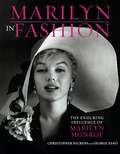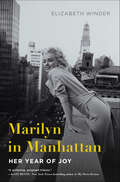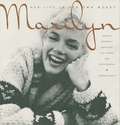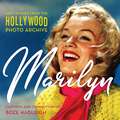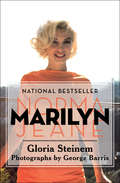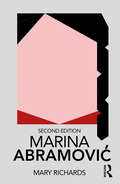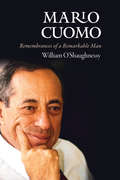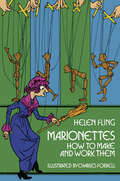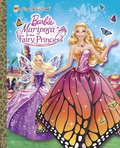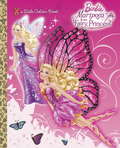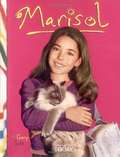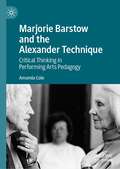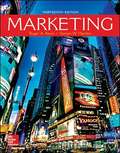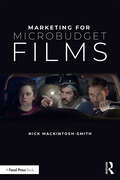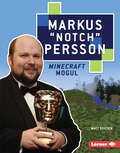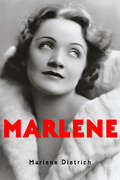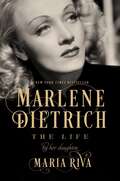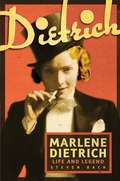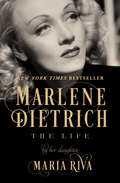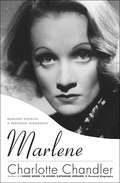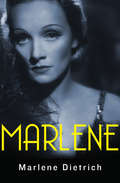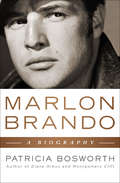- Table View
- List View
Marilyn in Fashion: The Enduring Influence of Marilyn Monroe
by Christopher Nickens George ZenoFifty years after her death, Marilyn remains an incandescent movie star, legendary sex symbol, and a woman whose private life fascinates the public--but the story never before showcased is Marilyn Monroe's enduring impact on fashion. <P><P>From the pink satin "Diamonds Are a Girl's Best Friend" gown, to the pleated white dress from The Seven Year Itch to the revealing nude sheath worn to sing "Happy Birthday" to JFK, Marilyn created endless unforgettable looks. Before they were household names, she wore Ferragamo pumps, carried Gucci bags and wore the designs of Oleg Cassini, Norman Norell, Emilio Pucci and Jean Louis. In an era of Peter Pan collars, poodle skirts, and repressed sexuality, Marilyn's sexy style and ability to spot up-and-coming designers made her a fashion visionary. Marilyn in Fashion traces the evolution of her style, from wholesome sweetness early in her career, to sex kitten looks in the '50s, to elegant sophistication in the last years of her life. The text details the designers of her ensembles, where she wore them, and their influence on fashion. Behind-the-scenes stories reveal how the star often worked closely with designers to create looks befitting the Marilyn Monroe image. Illustrated with hundreds of rare and never-before-published photos, Marilyn in Fashion fabulously traces the style evolution of the ultimate Hollywood icon.
Marilyn in Manhattan: Her Year of Joy
by Elizabeth WinderA city, a movie star, and one magical year.In November of 1954 a young woman dressed plainly in a white oxford, dark sunglasses and a black pageboy wig boards a midnight flight from Los Angeles to New York. As the plane’s engines rev she breathes a sigh of relief, lights a cigarette and slips off her wig revealing a tangle of fluffy blonde curls. Marilyn Monroe was leaving Hollywood behind, and along with it a failed marriage and a frustrating career. She needed a break from the scrutiny and insanity of LA. She needed Manhattan. In Manhattan, the most famous woman in the world can wander the streets unbothered, spend hours at the Met getting lost in art, and afternoons buried in the stacks of the Strand. Marilyn begins to live a life of the mind in New York; she dates Arthur Miller, dances with Truman Capote and drinks with Carson McCullers. Even though she had never lived there before, in New York, Marilyn is home.In Marilyn in Manhattan, the iconic blonde bombshell is not only happy, but successful. She breaks her contract with Fox Studios to form her own production company, a groundbreaking move that makes her the highest paid actress in history and revolutionizes the entertainment industry. A true love letter to Marilyn, and a joyous portrait of a city bursting with life and art, Marilyn in Manhattan is a beautifully written, lively look at two American treasures: New York and Marilyn Monroe, and sheds new light on one of our most enduring icons.
Marilyn: A Biography
by Norman MailerBiography about the iconic figure and movie star, Marilyn Monroe.
Marilyn: Her Life In Her Own Words
by George Barris"You Are The First One I'm Telling This To. I'll Tell You All. . ."No one looked like her. No one walked like her. No one talked like her. Sexy yet vulnerable, and unexpectedly talented, she was no ordinary screen goddess. Few really knew her. What others wrote, she called "Lies! Lies! Lies!" Here, at last, is Marilyn Monroe's account, in her own singular voice. It was June 1, 1962, her thirty-sixth birthday. Famed photographer and reporter George Barris had come to see Marilyn on the set of what would be her final, unfinished, film. They had met eight years earlier, became friends, and planned to do a picture book and autobiography. Now the time was right. For the next six weeks Barris photographed and interviewed the actress. "Don't believe anything you read about me except this. . ." she told Barris. And so she began to confide the truth about herself. Barris last talked to Marilyn on August 3, less than twenty-four hours before she was found dead in her apartment. At their last meeting, she was effervescent and eager to embrace life. "I feel I'm just getting started," she said. Barris firmly believes that murder, not suicide, caused Marilyn's untimely end and he could not bring himself to publish her thoughts or the haunting photos of that summer--until now. Marilyn: Her Life In Her Own Words is a candid memoir enhanced by 150 black-and-white and color photos, many never before published. A highlight is "The Last Photo Shoot" where Marilyn appears luminous without makeup on the beach at Santa Monica and in a North Hollywood house. This moving book brings Marilyn Monroe back--beautiful, flirtatious, and sweet as a first kiss--for one rare and radiant farewell.George Barris has worked as a photojournalist for many of the country's major magazines, from Life to Cosmopolitan. He is the co-author (with Gloria Steinem) of Marilyn-Norma Jean, and contributed to Norman Mailer's book, Marilyn. He lives in California.
Marilyn: Lost Images from the Hollywood Photo Archive
by Boze HadleighFrom the beginning of her modeling career in 1944 as Norma Jeane Mortensen to her death as the voluptuous Hollywood icon in 1962, Marilyn Monroe posed for thousands of modeling and publicity photos, scores of which have long been forgotten or abandoned in neglected studio archives. This book collects 100 of the rarest of the rare, seldom previously seen images of her brief modeling career, early days on the 20th Century Fox lot, then in candids between scene takes and traveling as a public figure as the wife of Arthur Miller and Joe DiMaggio. For the Monroe fans who think that they have seen it all, this book will provide a new lens on a beloved American icon.
Marilyn: Norma Jeane
by Gloria SteinemThe feminist icon and New York Times–bestselling author offers an intimate appraisal of the ultimate sex symbol—and the real woman behind the images. Few books have altered the perception of a celebrity as much as Marilyn. Gloria Steinem, the renowned feminist who inspired the film The Glorias, reveals that behind the familiar sex symbol lay a tortured spirit with powerful charisma, intelligence, and complexity. This national bestseller delves into a topic many other writers have ignored—that of Norma Jeane, the young girl who grew up with an unstable mother, constant shuffling between foster homes, and abuse. Steinem evocatively recreates that world, connecting it to the fragile adult persona of Marilyn Monroe. Her compelling text draws on a long, private interview Monroe gave to photographer George Barris, part of an intended joint project begun during Monroe&’s last summer. Steinem&’s Marilyn also includes Barris&’s extraordinary portraits of Monroe, taken just weeks before the star&’s death. &“An even-handed introduction to the Monroe phenomenon.&” —Library Journal
Marilyn: Norma Jeane
by Gloria SteinemThe feminist icon and New York Times–bestselling author offers an intimate appraisal of the ultimate sex symbol—and the real woman behind the images. Few books have altered the perception of a celebrity as much as Marilyn. Gloria Steinem, the renowned feminist who inspired the film The Glorias, reveals that behind the familiar sex symbol lay a tortured spirit with powerful charisma, intelligence, and complexity. This national bestseller delves into a topic many other writers have ignored—that of Norma Jeane, the young girl who grew up with an unstable mother, constant shuffling between foster homes, and abuse. Steinem evocatively recreates that world, connecting it to the fragile adult persona of Marilyn Monroe. Her compelling text draws on a long, private interview Monroe gave to photographer George Barris, part of an intended joint project begun during Monroe&’s last summer. Steinem&’s Marilyn also includes Barris&’s extraordinary portraits of Monroe, taken just weeks before the star&’s death. &“An even-handed introduction to the Monroe phenomenon.&” —Library Journal
Marina Abramović (Routledge Performance Practitioners)
by Mary RichardsMarina Abramović is the creator of pioneering performance art which transcends the form’s provocative origins. Her visceral and extreme performances have tested the limits of both body and mind, communicating with audiences worldwide on a personal and political level. Updated and revised throughout, the book combines: a biography, setting out the contexts of Abramović’s work an examination of the artist through her writings, interviews and influences a detailed analysis of her work, including studies of the Rhythm series, Nightsea Crossing and 512 Hours practical explorations of the performances and their origins. As a first step towards critical understanding, and as an initial exploration before going on to further, primary research, Routledge Performance Practitioners offer unbeatable value for today’s student.
Mario Cuomo: Remembrances of a Remarkable Man
by William O'ShaughnessyA personal, behind-the-scenes look at a Democratic iconGovernor Mario Cuomo’s life and accomplishments are part of the public record, but in Mario Cuomo: Remembrances of a Remarkable Man, William O’Shaughnessy gives readers an exclusive and a deeply personal, behind-the-scenes look at the liberal Democratic icon. This poignant memoir, based on the author’s thirty-eight-year friendship with Governor Cuomo, portrays the spiritual journey of a man who played many roles: inspirational political leader, moral compass, spellbinding orator, gifted author, legal scholar, and loving father and grandfather. He was, in O’Shaughnessy’s words, one of the most articulate and graceful public men of the twentieth century.
Marion's Angels (Pennington #4)
by K. M. PeytonMarion's Angels is an unusual novel about a lonely girl and her love for an impressive medieval church on the river marsh near her father's cottage. "That queer little Marion", the villagers would say, "Why would she want a church of her own?" But Marion, in an emotional tangle after her mother's death, didn't care what they thought of her strange fascination. She carefully tended the church and its twelve beautifully carved angels that seemed to her almost alive, praying intensely for the money to save it from ruin. A miracle seems to result from her passionate prayers for her angels. A world famous violinist takes up the cause and arranges a series of benefit performances. Marion is tumbled into a world of concerts and professional musicians--and a confusing web of relationships and connection with the supernatural. In the end crisis, one of Marion's angels seems to save her life--another miracle or just chance? This is a compelling novel for young people, sympathetically portraying a sensitive young girl and her mysterious glimpses of seemingly supernatural coincidences. Peyton, long acknowledged as an outstandingly original writer, tells this story with characteristic warmth and humor, and provides as well interesting insights into the world of professional musicians. It is a story that lingers with the reader long after it has been put down. K. M. Peyton was born in Birmingham, England, and educated at Wimbledon High School, Kingston School of Art and Manchester Art School. It was while an art student that she met her husband, who is a freelance commercial artist. Mrs. Peyton has been writing since she was nine--she had her first book published at fifteen--and when her first daughter was born, she gave up her job as an art teacher to follow a full-time career in writing. Since then she has won several awards, including the Carnegie Medal, and two of her books have been chosen as American Library Association Notable Books. Her celebrated trilogy Flambards has been televised in England.
Marionettes: How to Make and Work Them
by Helen FlingThis is the complete book of marionette craft -- from making heads and constructing bodies to stringing the marionettes on one- and two-hand controls, operating the marionettes, and putting on your own shows. Four books by Helen Fling have been brought together to make this volume. Their wealth of illustrations, tricks, helpful hints and solid, easy-to-follow advice will go far toward making your performances successful, enjoyable, and creative.In the first section, full details are given on making puppet and marionette heads -- creating them, molding them, casting them, making them out of plastic wood and pâpier-maché, painting them, and adding character details such as noses and wigs. The second section tells, in equal detail, how to make hands, feet, legs, arms, and bodies with a variety of methods for joining the parts together, taping, painting, finishing, and placing screw-eyes for mechanical perfection. The third section shows how to construct marionette controls, how to string your marionettes, and how to manipulate your controls for the movements, postures, gestures, and tricks. Costume and character details are also covered. By the end of this section both you and your characters should be ready to perform. The final section covers the details of marionette show production -- building a stage, lighting, scenery, sound effects, curtain-drops, and presentation. One complete play, with full details on stage props, marionettes, and background, is included. More than 400 helpful illustrations show every step of marionette craft from conception and construction to performance.Beginners will find this book to contain everything they need to know to construct marionettes and present their own shows. Puppeteers will find the chapter on head-making equally suited to their craft. Those who have some experience with marionettes will find the sections on tricks, alternate procedures, and professional methods to greatly increase their abilities to build marionettes and create a variety of new effects and successful marionette performances.
Mariposa and the Fairy Princess (Barbie)
by Golden Books Kristen L. DepkenGirls ages 3-7 will love this beautiful hardcover Big Golden Book based on the latest Barbie movie releasing in fall 2013 on DVD and Blu-ray.
Mariposa and the Fairy Princess (Barbie)
by Golden Books Mary TillworthGirls ages 2-5 will love this exciting full-color Little Golden Book retelling of the new Barbie direct-to-DVD/Blu-ray movie, releasing in fall 2013.
Marisol (American Girl Today)
by Gary SotoMeet Marisol, a girl who was born to dance, The upsetting news that her family is moving to the Chicago suburbs is made worse when Marisol learns that her new neighborhood doesn't have a dance studio. That means no tap, no jazz, no folklorico - not even classical ballet. Instead of giving up, resourceful Marisol is determined to find a way to keep dancing. With the help of two new friends, she figures out how to combine the best of her old world with a renewed commitment to stretch and try her hardest.
Marjorie Barstow and the Alexander Technique: Critical Thinking in Performing Arts Pedagogy
by Amanda ColeThis book focuses on the teaching and philosophy of the pioneering performing arts teacher and educator Marjorie Barstow. She is one of the best and brightest exponents of the Alexander Technique (AT), an approach to awareness and movement widely deployed and valued in the performing arts and outside artistic circles. By comparing her approach to the educational philosophy of John Dewey, this book resurrects Marjorie Barstow’s name, and gives her pedagogy and legacy the attention it deserves.
Marketing (13th Edition)
by Roger A. Kerin Steven W. HartleyKerin/Hartley's Marketing 13th edition is the most robust Principles of Marketing solution available to meet the needs of a wide range of faculty. Marketing focuses on decision making through extended examples, cases, and videos involving real people making real marketing decisions. The author team's decades of combined experience in the higher education classroom continue to inform the title's innovative pedagogical approach. Marketing is known for its conversational writing style, ability to engage students through active learning techniques, and vivid descriptions of businesses, marketing professionals, and entrepreneurs in cases, exercises, and testimonials that help students personalize marketing and identify possible career interests.
Marketing for Microbudget Films
by Nick Mackintosh-SmithIn Marketing for Microbudget Films, feature film director, producer and educator Nick Mackintosh-Smith shares a combination of blockbuster and indie techniques for targeting a dedicated audience. Mackintosh-Smith provides hands-on suggestions for strategies designed to match a variety of genres, territories and viewer tastes.Mackintosh-Smith, along with a diverse cross-section of industry veterans, offers advice on effective promotion, from building relationships with audience members to large-scale distribution companies. Readers will learn invaluable tactics, such as working with film commissions and other film-friendly organisations; the nuts and bolts of posters, trailers and bonus material; how to maintain audience interest during the postproduction process; as well as maximising the latest social media techniques in multiple territories.With indispensable facts, figures, case studies and resources, Marketing for Microbudget Films provides a wealth of techniques to use in a way that will inform, assist and motivate moviemakers of all levels.
Markus "Notch" Persson: Minecraft Mogul (Gateway Biographies Ser.)
by Matt DoedenMinecraft creator Markus "Notch" Persson has always loved programming. Find out how he translated his childhood passion for writing code into a multi-million dollar career as the mind behind Minecraft!
Marlene
by Marlene DietrichA fascinating self-portrait of one of the greatest entertainers of Hollywood&’s golden age Film star. Cabaret sensation. Recording artist. Writer. Marlene Dietrich was nothing short of enchanting—and remains so as she chronicles her fabulous rise to stardom in Marlene. From her early career in Germany as a chorus girl to her breakout role as Lola in The Blue Angel to her courageous wartime tours, Dietrich recounts a life that captivates on the page just as she smoldered on the screen. She writes passionately of her friends—including Charlie Chaplin, Orson Welles, and Edith Piaf, among many others—and she shares memories of what she calls her greatest accomplishment: entertaining the Allied troops during World War II. A sustained expression of her bold, sophisticated style, Marlene reminds us why Dietrich remains an international icon and a true Hollywood legend.
Marlene Dietrich
by Maria RivaThe twenty-fifth anniversary edition of the landmark biography that tells the full-scale, riveting, and untold story of Marlene Dietrich.Wildly entertaining, Maria Riva reveals the rich life of her mother in vivid detail, evoking Dietrich the woman, her legendary career, and her world. Opening with Dietrich&’s childhood in Berlin, we meet an energetic, disciplined, and ambitious young actress, whose own mother equated the stage with a world of vagabonds and thieves. Dietrich would quickly rise to stardom on the Berlin stage in the 1920s with her sharp wit and bisexuality—wearing the top hat and tails that revolutionized our concept of beauty and femininity. She would play vulgarity but not become in; startle the world but still maintain the aloofness of an aristocrat. As Riva herself remembers, &“At age three, I knew quite definitely that I didn&’t have a mother, I belonged to a queen.&” Marlene Dietrich comes alive in these pages in all of her incarnations: as muse, artistic collaborator, bonafide movie star, box-office poison, lover, wife, and mother. Dietrich would stand up to the Nazis and galvanize American troops, eventually earning the Congressional Medal of Freedom. There were her rich artistic relationships with Josef von Sternberg (The Blue Angel, Morocco, Shanghai Express), Colette, Erich Maria Remarque, Noël Coward and Cole Porter, and her heady romances. In her final years, she would make herself visibly invisible, devoting herself to the immortality of her legend. Maria Riva&’s biography of her mother has the depth, range, and resonance of a novel and captures the conviction and passion of its remarkable subject.
Marlene Dietrich: Life and Legend
by Steven BachFrom the stages of Berlin to anti-Nazi efforts and silver-screen stardom, Steven Bach reveals the fascinating woman behind the myth surrounding Marlene Dietrich in a biography that will stand as the ultimate authority on a singular star. Based on six years of research and hundreds of interviews—including conversations with Dietrich—this is the life story of one of the century&’s greatest movie actresses and performers, an icon who embodied glamour and sophistication for audiences around the globe.
Marlene Dietrich: The Life (Tribuna Ser.)
by Maria RivaNew York Times Bestseller: A “greatly entertaining” biography of the glamorous, mysterious German-born actress, written by her daughter (The New York Times). With intimate detail, author Maria Riva reveals the rich life of her mother, Marlene Dietrich, the charismatic star of stage and screen whose career spanned much of the twentieth century. Opening with Dietrich’s childhood in Schöneberg, Riva’s biography introduces us to an energetic, disciplined, and ambitious young actress whose own mother equated show business with a world of vagabonds and thieves. Dietrich would quickly rise to stardom on the Berlin stage in the 1920s with her sharp wit and bisexual mystique, and wearing the top hat and tails that revolutionized our concept of beauty and femininity. She comes alive in these pages in all her incarnations: muse, collaborator, bona fide movie star, box-office poison, lover, wife, and mother. During World War II, Dietrich would stand up to the Nazis and galvanize American troops, eventually earning the Congressional Medal of Freedom. There were her artistic relationships with Josef von Sternberg (The Blue Angel, Morocco, Shanghai Express), Colette, Erich Maria Remarque, Noël Coward, and Cole Porter, as well as her heady romances. And in her final years, Dietrich would make herself visibly invisible, devoting herself to the immortality of her legend. Capturing this complex and astonishing woman, Maria Riva’s insightful profile of her mother has the depth, range, and resonance of a novel, and takes us on a journey through Europe and old Hollywood during an era that is gone but not forgotten.
Marlene: Marlene Dietrich, A Personal Biography
by Charlotte ChandlerIn Marlene, the legendary Hollywood icon is vividly brought to life, based on a series of conversations with the star herself and with others who knew her well. In the mid-1970s Charlotte Chandler spoke with Marlene Dietrich in Dietrich’s Paris apartment. The star’s career was all but over, but she agreed to meet because Chandler hadn’t known Dietrich earlier, “when I was young and very beautiful.” Dietrich may have been retired, but her appearance and her celebrity—her famous mystique—were as important to her as ever. Marlene Dietrich’s life is one of the most fabulous in Hollywood history. She began her career in her native Berlin as a model, then a stage and screen actress during the silent era, becoming a star with the international success The Blue Angel. Then, under the watchful eye of the director of that film, her mentor Josef von Sternberg, she came to America and became one of the brightest stars in Hollywood. She made a series of acclaimed pictures—Morocco, Shanghai Express, Blonde Venus, Destry Rides Again, among many others—that propelled her to international stardom. With the outbreak of World War II, the fiercely anti-Nazi Dietrich became an American citizen and entertained Allied troops on the front lines. After the war she embarked on a new career as a stage performer, and with her young music director, the gifted Burt Bacharach—whom Chandler interviewed for the book—Dietrich had an outstanding second career. Dietrich spoke candidly with Chandler about her unconventional private life: although she never divorced her husband, Rudi Sieber, she had numerous well-publicized affairs with his knowledge (and he had a longtime mistress with her approval). By the late 1970s, plagued by accidents, Dietrich had become a virtual recluse in her Paris apartment, communicating with the outside world almost entirely by telephone Marlene Dietrich lived an extraordinary life, and Marlene relies extensively on the star’s own words to reveal how intriguing and fascinating that life really was.
Marlene: The Songbook
by Marlene DietrichA fascinating self-portrait of one of the greatest entertainers of Hollywood's golden age Film star. Cabaret sensation. Recording artist. Writer. Marlene Dietrich was nothing short of enchanting--and remains so as she chronicles her fabulous rise to stardom in Marlene. From her early career in Germany as a chorus girl to her breakout role as Lola in The Blue Angel to her courageous wartime tours, Dietrich recounts a life that captivates on the page just as she smoldered on the screen. She writes passionately of her friends--including Charlie Chaplin, Orson Welles, and Edith Piaf, among many others--and she shares memories of what she calls her greatest accomplishment: entertaining the Allied troops during World War II. A sustained expression of her bold, sophisticated style, Marlene reminds us why Dietrich remains an international icon and a true Hollywood legend.
Marlon Brando (Lives Ser.)
by Patricia BosworthThis biography of the legendary actor &“offers a fascinating look into his charismatic genius&” (Library Journal). In 1948 Marlon Brando stunned audiences and critics alike with his revolutionary, raw, and improvisational approach to acting. He became a symbol of a new, rebellious generation that was sick of conventions and committed to genuine emotion and unvarnished truth. From his breakout role as Stanley Kowalski in A Streetcar Named Desire to his mesmerizing portrayal of Don Corleone in The Godfather, he created some of the most memorable characters in American cinematic history. Brando was a paradox—intensely private but using his fame to promote worthy causes, a womanizer who clung to his childhood friends and animals. He was one of the most fiercely independent stars ever. In this book, acclaimed biographer Patricia Bosworth peels away Brando&’s many layers, revealing the struggles, triumphs, and relentless ambition that transformed the irrepressible farm boy from Nebraska into a legend of American cinema.
